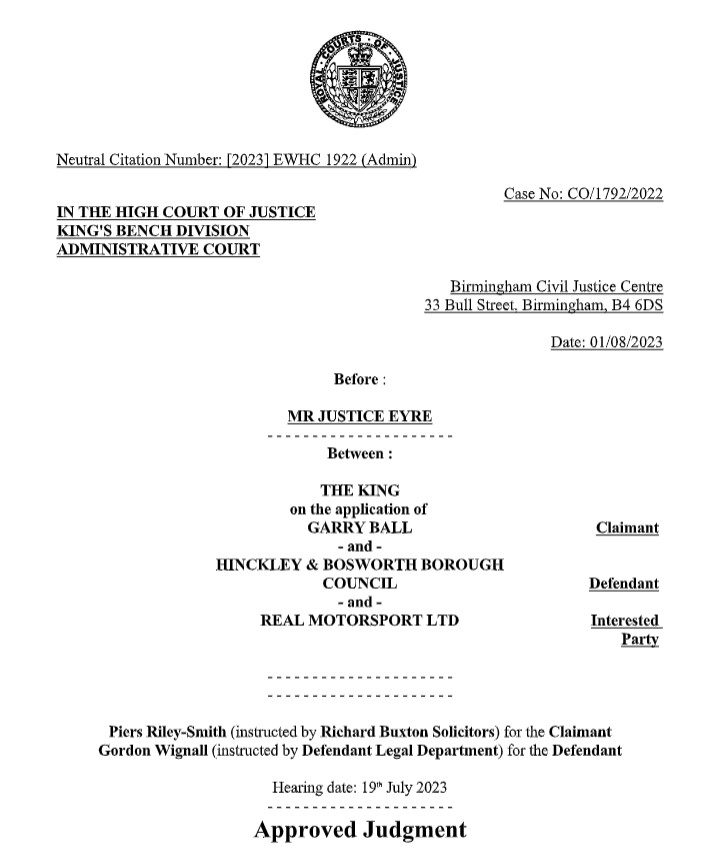
The King (Ball) v. Hinckley & Bosworth Borough Council (Real Motor Sport, Interested Party) CO/1792/2022, Eyre J., 1 August 2023 (full judgment below)
The High Court ruled today (1 August 2023) on the controversial question whether it is lawful for a Council to vary an abatement notice served under the statutory nuisance regime, deciding that it is, even if the result is a reduction in the restrictions which the notice imposes.
The decision came in a judicial review challenge by a local resident to motor-racing noise from the historic Mallory Park Racing Circuit, where the current abatement notice has been in place since 2014. The Mallory circuit is based in the village of Kirkby Mallory in Leicestershire, most of the properties being within 500 metres of the track.
The 2014 notice, served under s.80, Environmental Protection Act 1990 following a critical opinion from the Local Government Ombudsman, requires the operator (Real Motorsport Ltd) to restrict the recurrence of a statutory noise nuisance and to “cease or cause to cease the operation of the Mallory Park Racing Circuit by motor vehicles other than in accordance with the Schedule”.
The Schedule, which is annexed to the notice, lays down a regimen for the operation of the Circuit, defining noisy days, non-noise event days and quiet days (noisy days being sub-divided into race days, high noise days and medium noise days). The Schedule contains limits on how many noisy days are allowed every year, how often they can take place within certain periods and the hours when racing is permitted.
The variation provision at clause 21 of the Schedule states: “The operator may request any variation of this Schedule in writing and if a variation is agreed by the Council it shall take effect only on receipt by the Operator of written confirmation of the variation”. This procedure had been followed and resulted in variations by the Council in 2015, 2017, 2018 and in 2021.
The resident’s challenge was to a decision made in March 2022 to allow the operator’s request for a continuation of three variations which had been granted in previous years, this time variations which were expressed to be made permanent, albeit subject to annual review.
The three variations allowed for three consecutive noisy days once a year, for there to be a noisy day on a Friday once a month and for a shortening of the lunch break on a Boxing Day.
The Council’s position in its decision to allow the variations was that the limit on the total number of noisy days every year remained unchanged and that there was “no evidence of increased noise nuisance from previous variations”.
The claimant, on the other hand, objected that the result was an increased noise impact on residents in the village, including the provision of noisy days to be permitted in close proximity to each other. He described clause 21 as a “watering down” provision.
It is important to note that the claimant was not seeking to challenge the merits of the 2022 decision. His argument was that there is no legal power available to a Council to vary an abatement notice in the first place. It followed that clause 21 should not have been in the Schedule at all and that none of the variations since 2014 had been made lawfully. If the claimant had been right in this Administrative Court challenge, then the terms on which racing would be permitted by the Schedule would have had to revert back to those of the original Schedule dated 2014. Moreover, no future variations would be possible, and clause 21 would have been struck out from the abatement notice.
The fact that the challenge was to the lawfulness of the inclusion of clause 21 into the Schedule, rather than to the merits of the decision, meant that the Council had to identify a legal basis justifying the power to vary the contents of the Schedule. The judge who granted permission to make the judicial review application, Mrs Justice Steyn, acknowledged that there was no direct legal authority on the issue.
A key part of the judgment was consideration of R. v. Bristol City Council, Ex p. Everett, which concerned the question whether or not a local authority can withdraw an abatement notice once it had been served. Mr Justice Richards in 1998 and then the Court of Appeal in 1999 decided that a Council can do so, because otherwise the statutory nuisance provisions of Part III of the Environmental Protection Act 1990 would be unduly restrictive. (The references are [1999] 1 WLR 92 and [1999] 1 WLR 1170.)
In Ex p. Everett, the City Council had served an abatement notice in respect of a wooden staircase in the top of a house, which it decided was too steep to be safe. On re-consideration, however, the Council withdrew the abatement notice because it decided that a steep staircase did not fall within the statutory nuisance regime. The aggrieved resident took judicial review proceedings (losing in both Courts).
Whilst the key issue was whether the Council was correct to decide that such a staircase was not a public health risk (with the result that it could not be a statutory nuisance), Mr Justice Richards went on to decide that a power to withdraw an abatement notice had to be implied into the Environmental Protection Act 1990 because it would be “senseless” and “particularly unsatisfactory” to leave an abatement notice in place, given that the authority also had a discretion whether to prosecute. Such a power was also consistent with and promoted the purpose of the legislation. In the Court of Appeal, Lord Justice Mummery said little more than that “the council clearly had an implied power to withdraw the notice”, thereby making this a decision binding on the High Court.
In his judgment of 1 August, Mr Justice Eyre held that the Courts in Ex p. Everett had decided that the power to withdraw an abatement notice existed by “necessary implication”, rejecting an alternative submission by the Defendant that Mr Justice Richards had relied on s.111, Local Government Act 1972. Mr Justice Eyre also decided that the power to take the ‘greater’ step of withdrawal carried with it the ‘lesser’ step of variation and that the Mallory Park case could not be distinguished from Ex p. Everett.
The judge went on to examine the purpose of the statutory nuisance regime himself, especially the provisions in s.80 and in the Statutory Nuisance Appeals Regulations 1995 (s.i. 1995/2664), which, in summary, provide a defence of best practicable means in certain circumstances and which allow an allegation of a breach of an abatement notice to be defended on the basis that the accused has a “reasonable excuse”.
In his analysis, Mr Justice Eyre rejected both the claimant’s case that the statutory nuisance regime “operates in absolutes” and also the Defendant’s case that an abatement notice which has been drafted to “restrict” the recurrence of a nuisance allows a council “to hold a balance between the interests of those affected by statutory nuisances and those whose activities give rise to such nuisances”. He decided that “to the extent that there is a balancing exercise, the purpose of the Act is to provide for the removal of statutory nuisances, but for that to be done in a way which takes account of the existence of other factors, including the fact that the total removal of a nuisance might not be practicable and that in such circumstances the taking of the best practicable means to counteract its effects might be the most that can be achieved”.
In this context, “a power for a local authority to vary an abatement notice will promote the purposes of the Act in the same way as a power to withdraw would and essentially for the same reasons namely the avoidance of undue rigidity and the avoidance of artificiality flowing from the existence of the discretion not to prosecute”. It was open to a local authority, for instance, to conclude that the steps being taken by a business which was subject to an abatement notice amounted to best practicable means, so that a decision to prosecute would be “unimpeachable”. In those circumstances, it would also be “senseless” (as in Ex p. Everett) if the local authority could not vary the abatement notice so as to make it clear that the business could carry on if there was a reduced level of impact by reference to the business’ new practices.
There are many other aspects of this judgment which will be of interest to practitioners. These include a lengthy passage explaining when a new set of facts justifies the departure from a common law rule (stare decisis) and an argument that statutory interpretation and necessary implication are just stages in a single process.
In summary, Mr Justice Eyre decided that by necessary implication into the statutory nuisance regime of Part III, Environmental Protection Act 1990, local authorities have the power to vary abatement notices in order to reduce the restrictions which they contain. Since the power arises by reason of necessary implication and furthers the purpose of the 1990 Act, it follows that section 111, Local Government Act 1972 is, in effect, an irrelevance. Ex p. Everett established that an abatement notice can be withdrawn by reason of the necessity to imply such a power in order to meet the aims and purposes of Part III and there is no reason to distinguish the power to vary a notice: the power of withdrawal is a greater power than the power to vary, and the greater power encompasses the lesser. The judge expressly did not address the position where a variation of a notice might be used to increase the restrictions imposed by an abatement notice.
GORDON WIGNALL
1 August 2023

